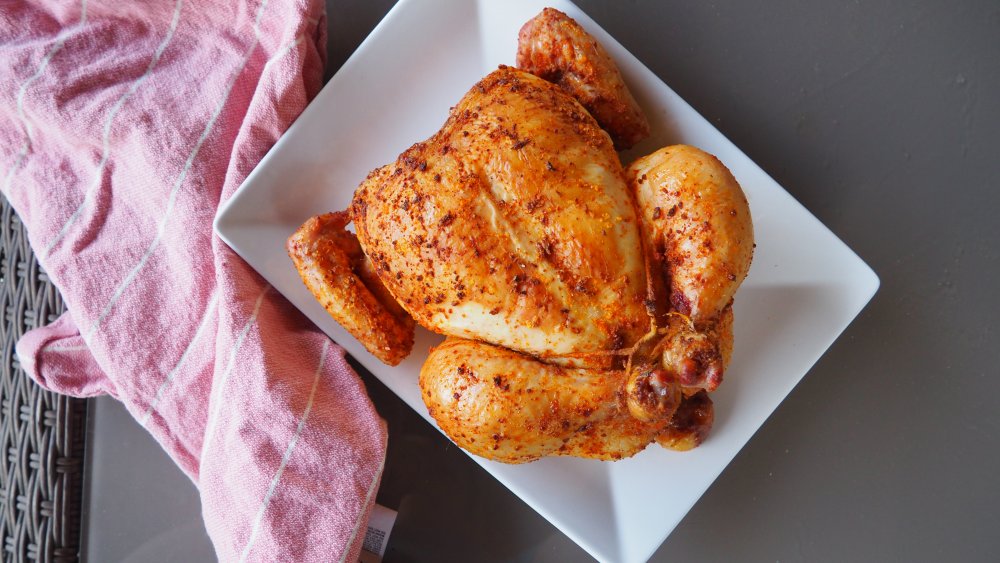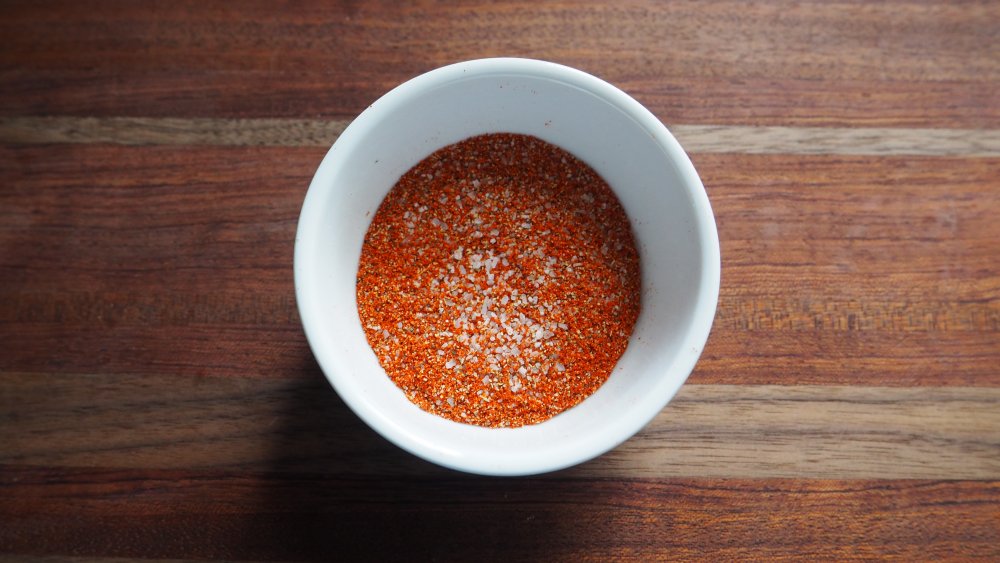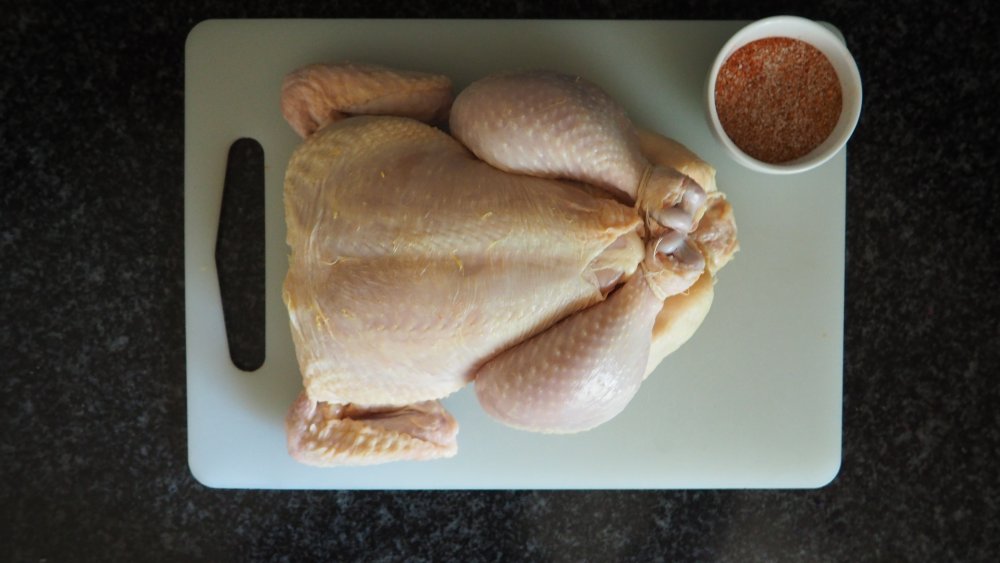5-Ingredient Copycat Costco Rotisserie Chicken Recipe
Honestly, it's hard to beat Costco's rotisserie chicken. It ranked number one as our top choice for grocery store rotisserie chickens for a reason: It's not only less expensive than an uncooked chicken (still available for $5, despite the rise in chicken prices), but it's also juicy, moist, tender, and flavorful. So why even try to make a copycat recipe at home? Could it possibly taste any better than the original?
After we read that Julia Child said the test of a good chef is "a perfectly roasted chicken," we knew we had to try. A whole roast chicken might be a simple meal, but it's elegant enough to serve for company when hosting a dinner party. It's also inexpensive enough to make a filling family meal, so we thought we'd try our hand at perfecting roast chicken with a replica of Costco's rotisserie chicken.
When we took on the challenge, we found out it is not only possible, but we could also do it with only five ingredients. Read on to learn how to make the 5-ingredient copycat Costco rotisserie chicken you can make at home.
Gather the ingredients for this 5-ingredient copycat Costco rotisserie chicken
The ingredients in Costco's rotisserie chicken are not a mystery — they're listed right there on the label. We were glad to see there was no MSG in the chicken, but we weren't interested in using most of the listed ingredients. We skipped right past the sodium phosphate, modified food starch (potato and tapioca), potato dextrin, carrageenan, sugar, and dextrose. Most of these items are either preservatives used to prevent bacteria growth or food additives that give the chicken an improved appearance.
We were definitely interested in the ingredient listed as "spice extractives." That means Costco doesn't use individual spices in their rotisserie chicken. Instead, the flavors are pulled out of the spices and mixed together to create a unique blend. Unfortunately, it's impossible to know what they are — the U.S. Food and Drug Administration (FDA) doesn't require companies to list these types of ingredients. So we gave it our best guess with garlic powder, paprika, and ground black pepper. From there, we added chicken and salt to our ingredients list and went about finding the perfect spice blend for our 5-ingredient copycat Costco rotisserie chicken.
For the full list of ingredients, including the step-by-step cooking instructions, scroll down to the instructions portion of this article.
Prepare the spice mixture for your 5-ingredient copycat Costco rotisserie chicken
Once we identified the flavors we wanted to include in our 5-ingredient copycat Costco rotisserie chicken, we had to determine the perfect quantity of each spice. We experimented with several different combinations before settling on our final mixture: two teaspoons salt, a teaspoon each garlic powder and paprika, and a quarter teaspoon black pepper. This combination provided the perfect amount of smoky, pungent, spicy, and salty flavor for our roast chicken.
At first glance, this combination might seem like too much salt, or way too much spice for a whole chicken. But when you consider that you'll rub the chicken inside and out, it will actually go pretty quickly. If you really like the mixture, you can definitely make a larger batch so you'll always have an all-purpose poultry rub on hand. Simply increase the quantities and store the mixture in an airtight container. When you're ready to season your chicken, use a tablespoon plus 1-1/4 teaspoons of the premade mixture.
Pat the chicken dry before making this 5-ingredient copycat Costco rotisserie chicken
The first step in making a perfect 5-ingredient copycat Costco rotisserie chicken is to make sure the skin is as dry as possible. In the next step, we'll let the chicken sit with the seasoning for at least 30 minutes to dry out the skin, but we want to start by physically drying the chicken skin to get a head start. After removing the chicken from the packaging, remove any giblets that might be present in the cavity. Then, grab a wad of paper towels and pat the chicken outside and inside until it's as dry as possible.
Why go through so much fuss? Epicurious explains that moisture creates steam, and steam is the enemy of crispy skin. Now, we're not really going for crispy skin on our copycat Costco rotisserie chicken. By the time the Costco's chicken sits in its plastic container underneath the heat lamps, the skin has turned quite soggy. But drying out the skin helps the meat retain more moisture, so it's a really important step anyway.
Truss the chicken for the perfect 5-ingredient copycat Costco rotisserie chicken
Okay, so trussing a chicken doesn't sound like fun, and it might even sound a little intimidating. But — trust us — it's easier than you think and it's absolutely necessary. Trussing meat with butcher's twine creates a neat, tight package that cooks more evenly. You see, meat expands as it cooks, which could cause it to cook unevenly. That could result in a chicken that has dry, overcooked breasts by the time the thighs cook through. Worse yet, part of the chicken could end up undercooked while the rest of it is cooked, causing salmonella poisoning.
We promised an easy process, so start by simply tucking the wings behind the chicken. Then, position the chicken breast-side up on the cutting board and place a long piece of string underneath the legs. Pull it until it's an equal length on each side. Then, form a loose figure 8 around the legs before pulling the string tight to squeeze the legs together. Finish by looping the string on top of the ankles, crisscrossing it near the chicken's cavity. Pull the string up toward the wings, hooking it on either side of the breast so you don't have a string mark on the cooked bird. Finally, flip the chicken over and tie the string around the back, near the wings.
Spice the chicken for this 5-ingredient copycat Costco rotisserie chicken
When the chicken is trussed, rub the spice mixture all over the chicken. You want to make sure to hit the entire outside as well as inside the chicken's cavity. If you're having trouble getting the spices to stick, you can rub a small amount of olive oil on the chicken's skin to help it adhere. Be sure to use the entire spice mixture, or the chicken will taste underseasoned after cooking.
Now that the chicken is coated with the spices, it's time to take a little rest. If you're running short on time, let the bird sit at room temperature for 30 minutes while you preheat the oven to 325 degrees Fahrenheit. Otherwise, go ahead and pop the chicken back into the refrigerator and let it sit, uncovered, overnight. This dry brine period will continue to dry out the skin, helping it crisp up and keep the meat juicy as it cooks. If you decide to put the chicken into the refrigerator, let it come back up to room temperature for 30 minutes while the oven preheats.
Roast the 5-ingredient copycat Costco rotisserie chicken for about two hours
From here, it's all about time and patience. Many chicken recipes call for a higher initial oven temperature around 450 degrees Fahrenheit before reducing the oven temperature to 350 or 375 degrees. That is the best way to get super crispy chicken skin, and it also cooks the chicken in about 90 minutes. That said, we found it's not the best way to create a 5-ingredient copycat Costco rotisserie chicken. As we mentioned earlier, Costco's chicken doesn't have crispy skin, so exposing the chicken to these high oven temperatures will unnecessarily dry out the meat.
Instead, we're going to take the low-and-slow approach. An oven temperature of 325 degrees does take longer than the previous method — at least two hours, if not 2-1/2 hours to reach a safe internal temperature. This gentle cooking method also results in a juicier, more flavorful chicken that reminded us of Costco's chickens. You'll know when the chicken is finished when the thickest part of the breast reaches 165 degrees with an instant-read thermometer (or 175 degrees in the thigh).
Let the 5-ingredient copycat Costco rotisserie chicken rest before carving it
The time to be patient has not yet passed. Before you slice into your perfectly cooked chicken, let it rest for at least 15 minutes. Resting the chicken allows the juices to redistribute within the meat instead of spilling out onto the cutting board. Costco keeps their chickens in plastic containers under a heat lamp, which produces extra steam. We doubt most home cooks have a hot box in their kitchen, so we replicated the steam by tenting the chicken with a piece of aluminum foil to keep it warm during this period.
If you're using the roast chicken as shredded chicken, skip the carving part. You can just dig into the bird with two forks to create long shreds of meat. Otherwise, if you want to serve the chicken on a platter, use a carving knife to slice the skin between the leg and body to expose the joint. Then, pull the leg away from the body and slice through the joint to remove the thigh and drumstick in one piece. Finish by removing the breast meat by making a long, horizontal cut from the top of the wing to the point where the leg used to meet the breast. Make a deep, vertical cut along the breastbone and cut in an angled, downward motion towards the horizontal cut. You can remove the wing by simply pulling it away from the body and cutting through the joint.
How close did we get to the original Costco rotisserie chicken?
Our 5-ingredient copycat Costco rotisserie chicken was pretty close to the original. It wasn't a 100 percent match — Costco's chickens are definitely saltier than this one, probably because they're injected with a saline solution that permeates deeper into the meat than our exterior salt rub. But our chicken was absolutely flavorful, and our low-and-slow cooking method resulted in perfectly juicy, moist meat. All in all, we had no complaints (other than the similar price tag with a whole heck of a lot more work!).
Our roasting pan was large enough that we could have fit two chickens on the rack, so we think we'll do that next time. For the amount of effort it took to make the chicken, we definitely would prefer to end up with twice the meat. The leftovers are easy to reheat and always taste fantastic on sandwiches or tacos. In a pinch, they can even be frozen if you really end up with more bird than you intended.
5-ingredient copycat Costco rotisserie chicken directions
This rotisserie chicken is juicy, flavorful, and perfect for a family meal. But is it possible to recreate this rotisserie chicken with just five ingredients?

Ingredients
- 2 teaspoons kosher salt
- 1 teaspoon garlic powder
- 1 teaspoon paprika
- 1/4 teaspoon ground black pepper
- 1 (3 to 4 pound) chicken
Directions
- In a small bowl, combine the salt, garlic powder, paprika, and ground black pepper. Set aside.
- Remove the chicken from the packaging and pat it dry with paper towels. Remove the giblets from the chicken's cavity, if present.
- Tuck the wings behind the chicken and truss the chicken by placing the bird breast-side up on a cutting board. Place a long piece of string underneath the legs, pulling it so it's equal length on each side. Form a loose figure 8 around the legs and pull the string tight to squeeze the legs together. Loop the string back to the top of the ankles and crisscross the string near the chicken's cavity. Pull the string up towards the wings, hooking it on either side of the breast. Flip the chicken over and tie the string around the back, near the wings.
- Rub the spice mixture all over the trussed chicken, inside and out, until it's well coated. If you're having trouble getting the spices to stick to the skin, rub a small amount of olive oil over the skin. Be sure to use all the spice mixture.
- Place the chicken on the rack of a roasting pan or an oven-safe wire rack placed inside a baking sheet. Let the bird sit at room temperature for 30 minutes to let the skin dry out. Alternatively, you can place it in the refrigerator and let it sit, uncovered, for up to 12 hours. If you're marinating the chicken in the refrigerator, bring it up to room temperature for 30 minutes while the oven preheats.
- When you're ready to cook, preheat the oven to 325 degrees Fahrenheit.
- Cook the chicken for 2 to 2-1/2 hours, until the thickest part of the breast reads 165 degrees and the thigh registers 175 degrees.
- Remove the chicken from the oven and tent it with a piece of aluminum foil. Let the chicken rest for at least 15 minutes before carving it.
Nutrition
| Calories per Serving | 390 |
| Total Fat | 27.2 g |
| Saturated Fat | 7.8 g |
| Trans Fat | 0.2 g |
| Cholesterol | 134.9 mg |
| Total Carbohydrates | 0.6 g |
| Dietary Fiber | 0.2 g |
| Total Sugars | 0.1 g |
| Sodium | 617.6 mg |
| Protein | 33.6 g |








